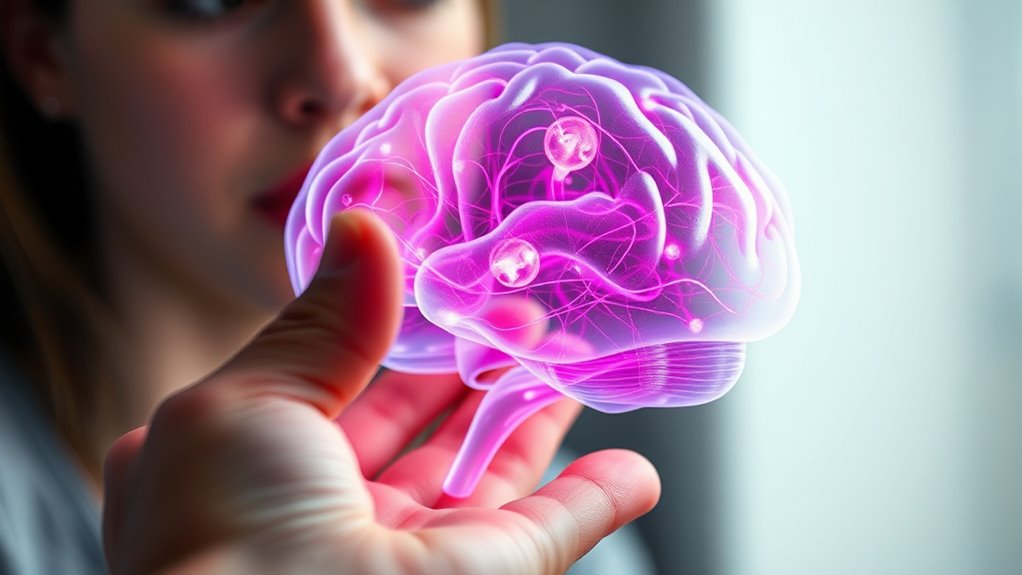If you have BPD, you likely experience heightened emotional sensitivity that makes your responses intense and quick to overwhelm you. Your brain reacts strongly to emotional cues, which can cause rapid mood shifts and challenges in understanding others’ feelings. While you might feel deeply connected emotionally, understanding others’ perspectives can be difficult. Recognizing how your brain and emotions influence empathy can help you navigate relationships better — and there’s much more to discover about this complex interplay.
Key Takeaways
- Individuals with BPD experience heightened emotional sensitivity, leading to intense reactions to both positive and negative stimuli.
- Neural differences in BPD affect emotional regulation and empathy, causing challenges in understanding others’ feelings.
- BPD often involves a paradox of deep emotional attunement paired with difficulties in maintaining relational harmony.
- Emotional hyper-reactivity impacts social interactions, making accurate interpretation of cues and empathy responses more complex.
- Recognizing emotional context and neural mechanisms can improve empathy and support targeted therapies for BPD.
The Nature of Emotional Sensitivity in BPD

What makes emotional sensitivity a defining feature of BPD? It’s because you respond more intensely to emotional stimuli than others. This heightened responsiveness means you feel both positive and negative emotions more deeply, often at lower thresholds. As a result, your emotional experiences can be rapid and overwhelming, leading to impulsive reactions. You might show a stronger startle response to environmental cues, indicating a pan-responsiveness to your surroundings. Studies reveal that your brain is hyper-reactive, especially to emotional content, making emotional shifts quick and intense. You recognize emotional expressions at lower intensities, but don’t necessarily interpret them more accurately. This sensitivity influences your social interactions, often causing emotional distress and challenges in maintaining stable relationships. Your emotional reactions are often more vivid and less controllable. Neuroimaging studies have demonstrated increased amygdala activity in response to emotional stimuli, further supporting the idea of heightened emotional reactivity in BPD. Additionally, research suggests that this emotional hyper-reactivity can lead to difficulties in emotion regulation, affecting daily functioning. Understanding the underlying neurobiological mechanisms can improve approaches to managing these reactions. Exploring brain circuitry involved in emotional processing can help develop targeted interventions. Incorporating mindfulness techniques can help manage these intense emotional responses by promoting awareness and acceptance of emotional experiences, which is crucial for emotional regulation. For example, oxidative stress plays a role in emotional reactivity, and managing it through lifestyle or therapeutic strategies may benefit individuals with BPD.
Distinguishing Between Cognitive and Emotional Empathy

Understanding the difference between cognitive and emotional empathy is crucial when exploring social functioning in BPD. Cognitive empathy is about understanding others’ feelings intellectually, but many with BPD find this challenging, especially during emotional turmoil. Emotional empathy, on the other hand, involves feeling others’ emotions deeply, which can be heightened or inconsistent in BPD. This emotional resonance can create powerful connections but also lead to overwhelm. Recognize that these abilities can fluctuate based on your emotional state and relationships. Research indicates that fluctuations in empathic abilities are common in BPD, influenced significantly by emotional context.
- Feel the pain of misunderstood emotions, knowing it’s a common struggle.
- Experience the intense connection that emotional empathy can bring—sometimes overwhelming.
- Understand that improving cognitive empathy is possible with targeted therapy and effort.
Brain Regions Involved in Empathy Processing

Several key brain regions are involved in processing empathy, each contributing differently to how you understand and experience others’ emotions. The anterior insular cortex is central, where the feeling of empathy originates, especially in emotional awareness. The right supramarginal gyrus shows increased activity in BPD patients during empathy for pain, particularly after witnessing painful facial expressions, highlighting emotional hypersensitivity. Conversely, the left supramarginal gyrus shows decreased activation when viewing angry faces, indicating altered emotional processing. The superior temporal sulcus (STS) and temporoparietal junction (TPJ) are less active in BPD, reflecting diminished cognitive empathy. Significantly, the left anterior insula exhibits variable activation depending on emotional context, emphasizing how emotional sensitivity shapes empathy processing in BPD. Developing strong problem-solving skills can help in understanding complex emotional responses involved in empathy. Additionally, understanding the cybersecurity vulnerabilities associated with digital tools can assist in safeguarding sensitive emotional data. Recognizing how brain regions interact during emotional processing can provide deeper insight into empathy differences in BPD. Moreover, recent studies highlight the importance of emotional regulation strategies in modulating activity within these regions. It is also important to consider how co-parenting strategies can influence emotional development and empathy in children affected by family separation.
Neural Patterns and Empathy in BPD

You’ll see that brain imaging reveals distinct activation patterns in individuals with BPD during empathy tasks. Their neural responses show increased activity in regions linked to emotional contagion, but reduced engagement in areas responsible for deliberate understanding. This neural imbalance explains why emotional processing is heightened while cognitive empathy remains impaired. Heightened emotional sensitivity is a core feature of BPD, influencing how these individuals perceive and react to social stimuli. Moreover, research into neural activation patterns highlights the importance of understanding the emotional and cognitive dimensions of empathy in BPD. Additionally, differences in brain structure may contribute to these atypical neural responses, emphasizing the complex neurobiological underpinnings of BPD. Recognizing the role of emotional regulation difficulties can further deepen our understanding of empathy challenges in BPD. These insights underscore the significance of emotional processing in shaping social interactions and relational dynamics in BPD. Furthermore, studies indicate that atypical neural connectivity patterns may underlie some of these emotional and cognitive disparities, revealing the multifaceted nature of empathy in BPD.
Brain Activation Differences
Research shows that individuals with BPD exhibit distinct neural patterns when processing empathy, which help explain their social and interpersonal challenges. You might notice reduced activity in key regions like the superior temporal sulcus (STS) and temporoparietal junction (TPJ), impairing cognitive empathy. Conversely, areas involved in emotional empathy, such as the right supramarginal gyrus, often show heightened responses, especially to painful or negative stimuli. This neural imbalance can intensify emotional reactions and hinder understanding others’ feelings. Studies using functional magnetic resonance imaging (fMRI) have confirmed these differences in brain activity during empathy tasks. — fMRI studies You may struggle to see others’ perspectives, leading to misunderstandings. The neural differences in BPD can also influence emotional regulation and exacerbate mood swings. Your brain might amplify pain signals, making emotional experiences overwhelming. This neural pattern can cause unpredictable reactions, complicating relationships. Additionally, understanding these neural mechanisms underscores the importance of neuroplasticity in developing effective therapies. Recognizing the brain activation differences can guide targeted interventions to improve social understanding and emotional management in BPD.
Emotional Processing Sensitivity
People with BPD often experience heightened emotional sensitivity, reacting more intensely to both positive and negative stimuli. This hyper-reactivity is especially prominent in interpersonal or conflict situations, where emotional triggers like perceived threats provoke strong responses. Neural patterns in BPD involve complex mechanisms that influence emotional processing, leading to affective decision-making difficulties and riskier choices in stressful contexts. Research indicates that high arousal states can cause cognitive and behavioral disinhibition, making it harder to regulate emotions effectively. Despite these challenges, executive functions such as working memory remain relatively preserved. When it comes to empathy, individuals with BPD may be highly attuned to interpersonal cues, which can enhance empathy but also lead to emotional overload. This overload often hampers their ability to empathize effectively, especially during intense emotional episodes, highlighting the importance of emotional regulation strategies in managing these responses. Additionally, understanding the neural mechanisms involved in emotional processing can inform more effective therapeutic approaches.
How Emotional Context Shapes Empathy Responses

Emotional context plays a crucial role in shaping how you respond to others’ feelings, influencing both your understanding and sharing of their emotions. It provides essential clues about what someone is experiencing, helping you interpret their words and actions more accurately. When you’re aware of the emotional setting, your cognitive empathy improves, allowing you to see their perspective clearly. Emotional context also affects how intensely you feel others’ emotions, guiding your affective responses. Cultural norms and social cues further modulate how empathy is expressed and received in different situations. Recognizing the influence of social and cultural factors can significantly enhance your empathic interactions. You might feel more connected when emotional cues match the situation’s context. Misreading emotional signals can lead to misunderstandings and distance. Recognizing the broader emotional cues helps deepen your empathic responses, especially when considering emotional context and their significance within specific environments. Additionally, understanding vetted information about emotional sensitivities can help you better navigate complex social interactions.
Empathy Deficits and Social Challenges in BPD

You may notice that people with BPD often struggle with social awareness, misinterpreting others’ intentions or emotions. These challenges lead to relationship difficulties, as they find it hard to build trust or maintain stable connections. Understanding these social deficits can help you better navigate and support those affected by BPD. Empathy deficits, particularly in recognizing and understanding others’ emotional states, play a significant role in these social challenges. Additionally, mindful decluttering strategies can be metaphorically applied to social interactions, encouraging clearer boundaries and reducing emotional clutter that may hinder understanding. Recognizing the importance of personality traits such as emotional sensitivity can enhance empathy and foster healthier relationships. Furthermore, awareness of electric dirt bike horsepower can metaphorically represent the intensity of emotional responses, helping to contextualize emotional reactions in BPD.
Impaired Social Awareness
Individuals with borderline personality disorder (BPD) often struggle with social awareness, which hampers their ability to interpret and respond appropriately to social cues. This impairs their understanding of others’ feelings and intentions, leading to misunderstandings and strained interactions. You might find it hard to recognize subtle signals or emotional shifts, making social situations overwhelming. This can result in feelings of isolation and frustration.
- Misreading emotions may cause you to react defensively or aggressively, escalating conflicts.
- Focusing on negative feedback deepens misunderstandings and worsens emotional distress.
- Difficulty in reading social signals often leads to feelings of loneliness and disconnection, reinforcing social withdrawal.
These challenges create a cycle of miscommunication, impacting your relationships and overall well-being, making social functioning more difficult and emotionally taxing.
Relationship Difficulties
Struggling to interpret social cues and emotional signals often leads to ongoing relationship difficulties for those with BPD. You may find it hard to understand others’ thoughts and feelings, which causes misunderstandings. This challenge is worsened by negative biases and extreme evaluations of others’ actions. Emotional sensitivity can heighten reactions, leading to emotional overload and trust issues. Here’s a quick look at some key social challenges:
| Challenge | Impact | Example |
|---|---|---|
| Empathy deficits | Misinterpretation of social cues | Thinking a neutral comment is hostile |
| Emotional dysregulation | Mood swings strain relationships | Reacting intensely to minor issues |
| Negative biases | Misjudging others’ intentions | Assuming betrayal without cause |
| High arousal | Impaired social judgment | Overreacting during conflicts |
| Trust issues | Difficulty forming close bonds | Avoiding intimacy altogether |
The Paradox of Enhanced Emotional Empathy

How can someone with BPD simultaneously experience heightened emotional empathy and still struggle to maintain healthy relationships? This paradox occurs because, while you may be intensely attuned to others’ feelings, that awareness doesn’t always translate into effective responses. You might detect subtle emotional signals but find it hard to regulate your reactions or interpret them accurately.
- You feel others’ pain deeply, yet struggle to manage your own emotional overwhelm.
- Despite sensing emotional cues clearly, you often misjudge intentions or react impulsively.
- Your heightened empathy can lead to emotional contagion, amplifying negative feelings and increasing conflict.
This disconnect can make relationships feel unpredictable and exhausting, even when your emotional sensitivity is strong. The paradox lies in feeling deeply but not always connecting effectively.
Research Findings and Variability in Empathy Studies

Research into empathy in BPD reveals a complex and sometimes contradictory picture, with findings varying markedly across studies. You’ll find that some research reports deficits in empathy, especially in cognitive understanding, while others highlight heightened emotional responses. Variability stems from different measurement tools, like the Interpersonal Reactivity Index, Faux Pas Recognition Test, and self-report questionnaires. For example:
| Study Type | Key Finding | Notable Limitation |
|---|---|---|
| Empathy Deficit Studies | Impaired cognitive empathy in BPD | Reliance on self-report |
| Enhanced Emotional Empathy | Increased emotional empathy, personal distress | Small sample sizes |
| Neurobiological Research | Reduced cognitive empathy brain activation | Variability in imaging techniques |
| Theory of Mind Studies | Differences in cognitive but not emotional understanding | Mixed results |
| Experimental vs. Self-Report | Discrepancies in empathy assessment methods | Potential bias |
This variability emphasizes the nuanced nature of empathy in BPD.
Clinical Implications for Treatment and Support

You need to tailor empathy strategies to address each patient’s unique emotional and cognitive needs. Supporting emotional regulation is essential for improving interpersonal functioning and fostering trust in therapy. By customizing approaches and focusing on emotional stability, you can enhance treatment effectiveness for individuals with BPD.
Tailoring Empathy Strategies
Tailoring empathy strategies for individuals with BPD is essential because their emotional sensitivities and triggers vary widely. You need to recognize each person’s unique emotional landscape to foster trust and safety. Use active listening to fully understand their words without judgment, validating their feelings with supportive phrases. Recognize and acknowledge their struggles without minimizing their experiences, creating a non-threatening environment. Employ mindfulness techniques to stay present and respond empathetically. Allow space for emotional processing, respecting their heightened sensitivities. Focus on validating intense emotions rather than trying to fix them immediately.
- Avoid known triggers to prevent escalation and promote stability.
- Use calm, soothing body language and tone during emotional distress.
- Encourage safe self-expression to support emotional release and connection.
Supporting Emotional Regulation
Supporting emotional regulation in individuals with BPD requires targeted treatment approaches that address their core emotional challenges. Dialectical Behavior Therapy (DBT) is highly effective, focusing on emotional regulation, distress tolerance, and mindfulness. You’ll engage in individual therapy, group skills training, and supplementary sessions to build coping skills. Cognitive-behavioral treatments emphasize teaching healthier ways to manage intense emotions, leading to better relationships and overall well-being. Recognizing emotional dysregulation as central to BPD helps tailor your treatment plan, incorporating practices like mindfulness and self-compassion. Challenges exist, but hope remains, especially with professional support. Incorporating strategies like exercise, mindfulness, expressive writing, and mood diaries can promote emotional stability. Utilizing mental health apps and peer support groups complements therapy efforts, helping you achieve lasting emotional balance.
Moving Forward: Future Directions in Empathy Research

Advances in neuroimaging and second-person neuroscience are opening new avenues to investigate empathy in individuals with BPD by capturing real-time social interactions. You can now explore how neural activity shifts during genuine exchanges, revealing the complexity of emotional responses. Hyperscanning allows you to see how brains synchronize during trust or rejection, offering insight into social dysfunction. These methods highlight that empathy in BPD isn’t simply impaired; it varies with context and emotional cues. Future research can identify neural markers to tailor interventions, improving social functioning. By understanding these dynamic processes, you move closer to effective therapies that address the emotional sensitivities unique to BPD.
- Feel the power of real-time social connection revealing hidden emotional worlds.
- Witness how brain synchronization exposes vulnerabilities and strengths in empathy.
- Discover hope through targeted treatments informed by cutting-edge neuroscience.
Frequently Asked Questions
How Does Emotional Sensitivity Influence BPD Patients’ Daily Functioning?
Your emotional sensitivity can profoundly impact your daily life. When you experience heightened emotions, you might find it hard to manage stress, leading to impulsive actions or self-harm. Social interactions become more challenging, causing misunderstandings or conflicts. This emotional turbulence can disrupt your work or school routines, drain your energy, and reduce your overall well-being. Recognizing this influence helps you develop healthier coping strategies and improve your daily functioning.
Can Empathy Enhancement Improve BPD Treatment Outcomes?
Imagine you’re working with someone who struggles to see things from others’ perspectives. Improving their empathy could help them better understand and connect. Enhancing empathy can lead to fewer conflicts and stronger relationships. You can do this through therapies like DBT, which focus on emotional regulation. As their empathy grows, they’re more likely to manage emotions effectively, reducing harmful behaviors and improving overall treatment outcomes.
Are There Specific Therapies Targeting Empathy Deficits in BPD?
You’re asking if there are specific therapies targeting empathy deficits. Yes, therapies like Mentalization-Based Treatment (MBT) focus directly on improving your ability to understand others’ mental states, which enhances empathy. Dialectical Behavior Therapy (DBT) also helps by teaching mindfulness and interpersonal skills, indirectly boosting empathy. These approaches aim to strengthen your emotional awareness and relationships, making it easier for you to connect with others and navigate social situations effectively.
How Do Cultural Differences Affect Empathy Expression in BPD?
Oh, how amusing it is that cultures, with all their differences, shape empathy in ways you’d never expect. You might think empathy’s universal, but in reality, it varies wildly—some cultures express it openly, others hide it behind shame or Guilt. This means your ability to recognize and show empathy depends heavily on cultural norms, making cross-cultural understanding essential for accurate diagnosis and effective treatment of BPD.
What Role Do Genetics Play in Empathy Anomalies Associated With BPD?
Genetics influence how you experience empathy, especially in emotional sensitivity. Variations in genes like the oxytocin receptor can affect your empathic concern and response to others’ emotions. These genetic factors interact with environmental influences, shaping your empathic abilities. For example, certain gene variants may make you more prone to empathic dysfunction, impacting your relationships. Understanding these genetic contributions helps clarify why some individuals struggle with empathy-related challenges.
Conclusion
As you explore the nuanced landscape of empathy in BPD, imagine a delicate dance where emotional tides can both lift and challenge you. Understanding this balance helps you navigate relationships with greater compassion and insight. By recognizing the intricate patterns beneath the surface, you can foster deeper connections and gentle growth. Embrace this journey as an unfolding story, where each step reveals new colors of empathy, guiding you toward healing and harmony.
Theresa is the visionary force behind Borderline Syndrom, steering our content towards excellence and integrity. With a keen eye for detail and a deep understanding of BPD, she ensures that our articles, stories, and resources offer our readers valuable insights, hope, and guidance. Theresa’s leadership not only shapes our editorial direction but also fosters a space where voices on BPD are heard and respected.










